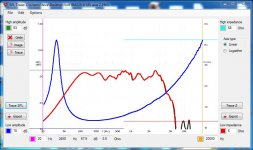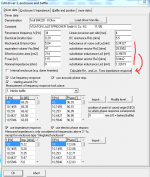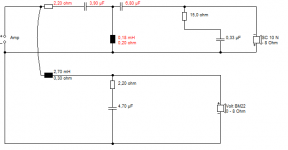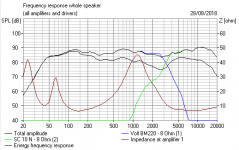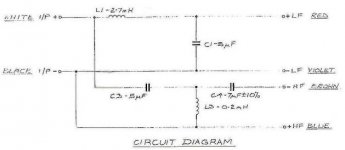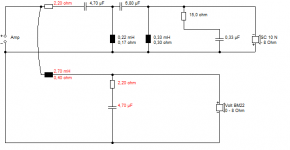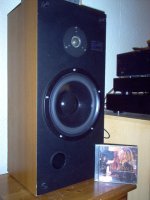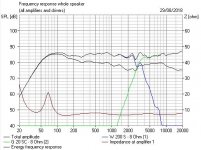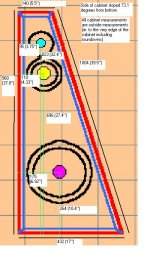I'm sure Nigel would be very pleased, and I would be interested, if you could knock something up for his Volt BM220.8 and a SEAS 27TBFC/G H1212-06 in that VituixCAD thingie of yours.I don't have to listen common speaker concepts, but it is fun part of the project and might give some experience for the future. Unfamiliar concepts need listening and tuning for studying how simulation should be.
Take you 10 minutes wouldn't it! You can try my circuit if you want a point of departure. It sounds good, IMO.
Nigel, I had a brief look at your Volt BM220.8 and particularly the Scan D2905/9700. Doesn't look to me like the 88dB Scan goes loud enough for the 90dB Volt bass. The Scan has a particularly horrible 32 ohm Fs impedance too. Because there is so little wiggle room on level, you can't do the usual resistive tricks to deal with the Fs problem either.
That SEAS is indicated here. Or something else near 91dB. I think the circuit above I showed you will work with a 91dB tweeter and your Volt without modification.
Take you 10 minutes wouldn't it!
Looks that you're (still) talking about quick and dirty sketching with some simulations, assumptions and design cloning, without valid measurement data from drivers in prototype or final enclosure - what ever radiator types and drivers are? It is not what I meant and do because it's just too crap and limited method for my purposes. I believe you have to listen, and that's totally okay with your design style and tools.
I wouldn't think there is anything very hard about the H1212-06 27TBFC/G.
But you obviously give yourself an easier life by crossing it high and steep with a filter that is electrically flattish. It's gonna sound better. My "Half Zobel" of 15R and 0.33uF that everyone found a achingly funny wheeze works very well to get the very top end sounding realistic.
I want to get back to Kimmo here. If you're in a thread, IMO, you better put some work in. Talk is cheap.
I ran into problems with this Volt BM220.8. It has a rather troublesome peak around 700Hz. Maybe a surround issue. I really don't know what I am doing with SPL Trace in VituixCAD. I really just wanted decent FRD and ZMA files for Boxsim. Not sure what gives with phase and acoustic centre either. This is where I am so far on any old 91dB tweeter. Just using that old reliable Celestion tweeter filter. Haven't tried to import the SEAS files yet.
Am I doing the SPL trace right? Below is just before I export the two files. I know as little about VituixCAD as you do about Boxsim, so lets help each other.
But you obviously give yourself an easier life by crossing it high and steep with a filter that is electrically flattish. It's gonna sound better. My "Half Zobel" of 15R and 0.33uF that everyone found a achingly funny wheeze works very well to get the very top end sounding realistic.
I want to get back to Kimmo here. If you're in a thread, IMO, you better put some work in. Talk is cheap.
I ran into problems with this Volt BM220.8. It has a rather troublesome peak around 700Hz. Maybe a surround issue. I really don't know what I am doing with SPL Trace in VituixCAD. I really just wanted decent FRD and ZMA files for Boxsim. Not sure what gives with phase and acoustic centre either. This is where I am so far on any old 91dB tweeter. Just using that old reliable Celestion tweeter filter. Haven't tried to import the SEAS files yet.
Am I doing the SPL trace right? Below is just before I export the two files. I know as little about VituixCAD as you do about Boxsim, so lets help each other.
Attachments
Not sure what gives with phase and acoustic centre either.
From user manual: "Phase response is calculated automatically as minimum phase. Program estimates slopes of frequency response extensions below and above visible range."
That is: Acoustic center of minimum phase response is 0 -> you need to estimate what is the distance from baffle surface (or other reference point) to acoustic center of driver and set that value to distance (Z) coordinate of driver in crossover simulation.
If XO simulator you are using has FR slope estimation and minimum phase extraction, you can copy responses from SPL Trace in "raw format" with Edit
-> Copy raw SPL/Z. Data has traced frequency+magnitude points only.
PS. I don't have a plan to use Boxsim, but thanks.
I'm sure Nigel would be very pleased, and I would be interested, if you could knock something up for his Volt BM220.8 and a SEAS 27TBFC/G H1212-06 in that VituixCAD thingie of yours.
Take you 10 minutes wouldn't it! You can try my circuit if you want a point of departure. It sounds good, IMO.
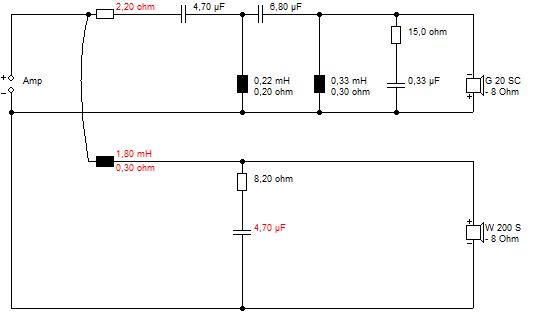
Nigel, I had a brief look at your Volt BM220.8 and particularly the Scan D2905/9700. Doesn't look to me like the 88dB Scan goes loud enough for the 90dB Volt bass. The Scan has a particularly horrible 32 ohm Fs impedance too. Because there is so little wiggle room on level, you can't do the usual resistive tricks to deal with the Fs problem either.
That SEAS is indicated here. Or something else near 91dB. I think the circuit above I showed you will work with a 91dB tweeter and your Volt without modification.
Thanks for your input Steve and Kimmosto. Yes I would love an expert to sim my selection as I am a complete novice. I thought buying a kit of parts and then designing my own cabs would be easy. However, after reading various posts I have realised that this is not the case, when it comes to crossovers. I will be procuring a mic and measuring software shortly to enable me to do the job right. In the meantime, a close assimilation will do just fine. attached is a drawing of my front baffle.
Many thanks, Nigel
Attachments
I'm not too sure about this at all, Nigel. And Kimmo wasn't much help. Maybe its a bit too much change to go from paper cone to polycone. I've been playing some more with the software, and there is some severe difficulty with the acoustic centre of the bass when I import the FRD and ZMA from the Volt graph. It seems to work if I move the bass 50mm forward from where I thought it would be.
I have a feeling I have got something right now, and I am suspecting the below bass circuit might be better. It's still quite a poor response with the Volt BM220.8, but I can't think how to fix it without a lot more components.
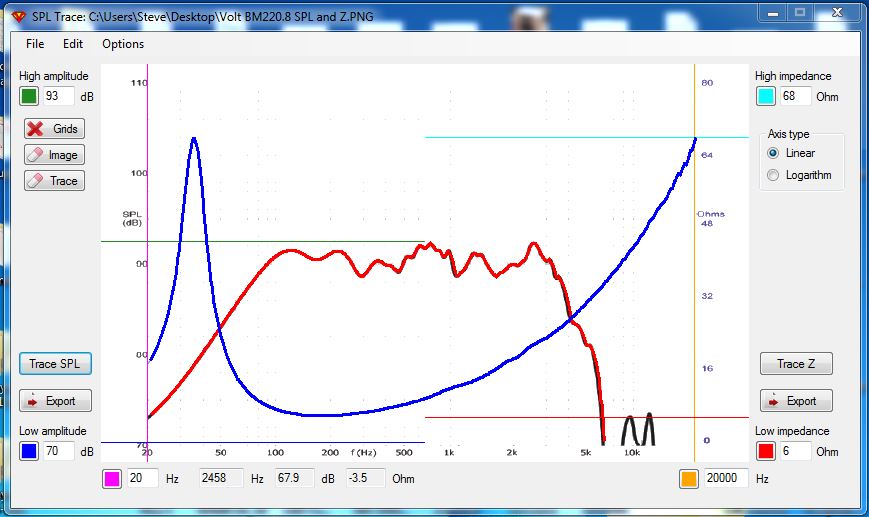
It's the peak at 700Hz that is difficult. The tweeter circuit ought to be OK with the 91dB SEAS 27TBFC/G anyway. The bass circuit looks familiar enough. Often used, as in the KEF Celeste III, below. I just don't have the modelling to be very sure about all this. It's not wildly different from the 1.8mH/8.2R plus 4.7uF circuit, just takes the midrange down 2dB.
Your 30cm baffle should be OK. I used 25cm. Not much in it.
I have a feeling I have got something right now, and I am suspecting the below bass circuit might be better. It's still quite a poor response with the Volt BM220.8, but I can't think how to fix it without a lot more components.
It's the peak at 700Hz that is difficult. The tweeter circuit ought to be OK with the 91dB SEAS 27TBFC/G anyway. The bass circuit looks familiar enough. Often used, as in the KEF Celeste III, below. I just don't have the modelling to be very sure about all this. It's not wildly different from the 1.8mH/8.2R plus 4.7uF circuit, just takes the midrange down 2dB.
Your 30cm baffle should be OK. I used 25cm. Not much in it.
Attachments
Last edited:
I think you have enough to have a go at this.
I would. The cabinet should be easy enough, and I think you can go to Wilmslow Audio for boxes and crossovers here if it is all too difficult.
SM108 Near Field HOME STUDIO MONITOR
In fact that one uses the BM228.8 and D2905/9700. Can't be wildly different from your drivers. I think they used to do a design with the BM220.8.
Sizewise the two Volt basses are identical, the bass tuning almost the same, and the two tweeters we have been talking about are both 104mm. Which is handy.
I wanted to mention this as one of those other handy things in crossovers, but if you get a nicely behaved tweeter filter, you often just adjust the bass response to match it, even with a different driver. The two slopes then just combine into one smooth whole. I actually only use about 3 circuits for tweeters ever. A couple of third orders, and a fourth order. Tweeters are usually flat anyway. I tend to avoid 4 ohm tweeters because they need huge and expensive capacitors.
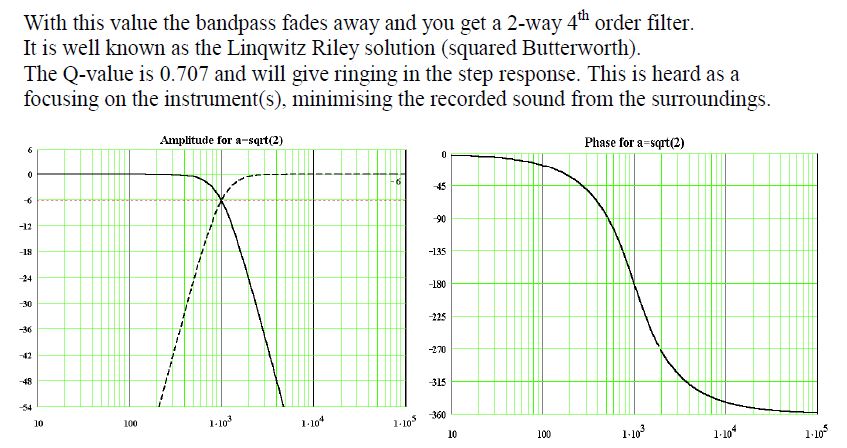
I would. The cabinet should be easy enough, and I think you can go to Wilmslow Audio for boxes and crossovers here if it is all too difficult.
SM108 Near Field HOME STUDIO MONITOR
In fact that one uses the BM228.8 and D2905/9700. Can't be wildly different from your drivers. I think they used to do a design with the BM220.8.
Sizewise the two Volt basses are identical, the bass tuning almost the same, and the two tweeters we have been talking about are both 104mm. Which is handy.
I wanted to mention this as one of those other handy things in crossovers, but if you get a nicely behaved tweeter filter, you often just adjust the bass response to match it, even with a different driver. The two slopes then just combine into one smooth whole. I actually only use about 3 circuits for tweeters ever. A couple of third orders, and a fourth order. Tweeters are usually flat anyway. I tend to avoid 4 ohm tweeters because they need huge and expensive capacitors.
Last edited:
And Kimmo wasn't much help.
Sorry that I don't do remote speaker design first aid anymore (other than my native language). My role in global diy scene is "just" offering free tools and briefly documented methods to enable good results with fast and controlled measurement and design methods. Hopefully that is adequate.
If I had to translate into my mother language, I would guess sottomano meant "Soft Hands".
It's one of those correct principles of that bizarre but loveable, and tough, game of Cricket, that if a hard ball is coming into your hands at very high speed, you need soft or relaxed hands to take the catch.
Not a game for Crybabies and Whingers, despite the outward politeness. It's brutal. You get one chance, and if you mess up, you're OUT!
Whatever. The topic here has segued into getting Nigel's 8" Volt speakers working. I don't know an awful lot about polycones. Lots of cone damping, an' all that.
My current 8" paper cone effort is really working splendidly well. I definitely didn't do this in VituixCAD. Look at that lovely impedance! I just don't know quite how to do this with the Volt unit. And none of you monkeys are helping either. True.
For the interested student, that Visaton W200S-8 might as well be any old 8" paper bass. The Morel MDT29 aka CAT298 soft dome is actually amazing me with its musicality on a good filter. I underestimated it. Superb.
It's one of those correct principles of that bizarre but loveable, and tough, game of Cricket, that if a hard ball is coming into your hands at very high speed, you need soft or relaxed hands to take the catch.
Not a game for Crybabies and Whingers, despite the outward politeness. It's brutal. You get one chance, and if you mess up, you're OUT!
Whatever. The topic here has segued into getting Nigel's 8" Volt speakers working. I don't know an awful lot about polycones. Lots of cone damping, an' all that.
My current 8" paper cone effort is really working splendidly well. I definitely didn't do this in VituixCAD. Look at that lovely impedance! I just don't know quite how to do this with the Volt unit. And none of you monkeys are helping either. True.
For the interested student, that Visaton W200S-8 might as well be any old 8" paper bass. The Morel MDT29 aka CAT298 soft dome is actually amazing me with its musicality on a good filter. I underestimated it. Superb.
Attachments
Those with the expertise, contributing on here, in my opinion should take some pride in mentoring novices, like myself as System seven(Steve) does. I am always grateful for the education I get from responses. However, I take a dim view of people resorting to infantile politics as in the case of sottomano.
@system7 - Attached is a 27TBFC/G FRD with minimum phase extracted. Also attached is an image of the baffle this measurement was taken on. Baffle diffraction / ripple will be different but this should get you in the ballpark.
PS: Phase is HBT min phase extraction (not measured phase).
PPS: Ignore the extended "tails" in the response below 100Hz and above 20Khz - this is an artefact of the normalisation process to do a HBT min phase extraction. Won't matter for xover sim.
PS: Phase is HBT min phase extraction (not measured phase).
PPS: Ignore the extended "tails" in the response below 100Hz and above 20Khz - this is an artefact of the normalisation process to do a HBT min phase extraction. Won't matter for xover sim.
Attachments
You seem to know more about the SEAS 27TBFC/G than I do! 
What is that FRD file, and where or how did you get it?
Surely you need the ZMA file too?
But are you expecting me to do something with it?
I just assume the tweeter is flattish, of a given loudness, and wing it on a high order filter. Works for me.
I was curious what HBT might be. Turns out it is the Hilbert Transform. How have I gone through life and signal processing without knowing about it?
Hilbert transform - Wikipedia
My goodness. It's brilliant. I should have known about that one 35 years ago. It puts on a mathematical footing everything I've been doing intuitively for years.
What is that FRD file, and where or how did you get it?
Surely you need the ZMA file too?
But are you expecting me to do something with it?
I just assume the tweeter is flattish, of a given loudness, and wing it on a high order filter. Works for me.
I was curious what HBT might be. Turns out it is the Hilbert Transform. How have I gone through life and signal processing without knowing about it?
Hilbert transform - Wikipedia
My goodness. It's brilliant. I should have known about that one 35 years ago. It puts on a mathematical footing everything I've been doing intuitively for years.
- Status
- This old topic is closed. If you want to reopen this topic, contact a moderator using the "Report Post" button.
- Home
- Loudspeakers
- Multi-Way
- Baffle step diffraction
